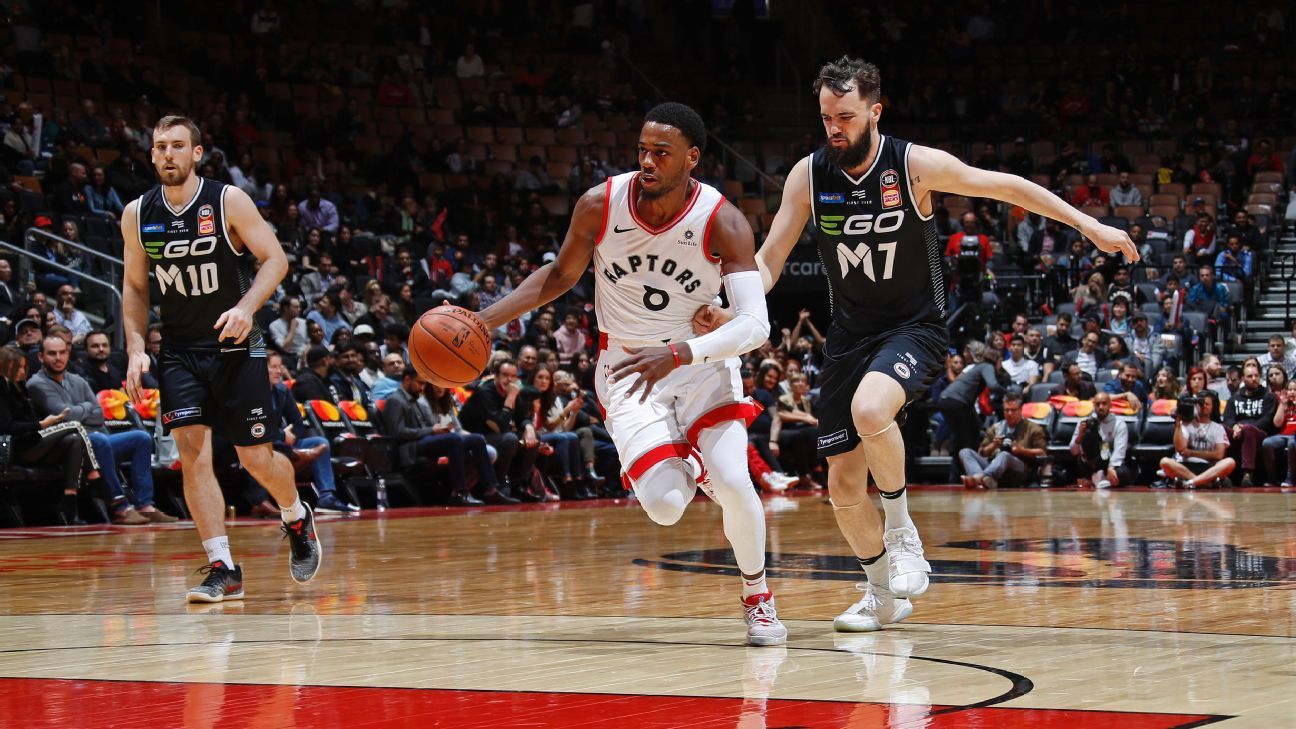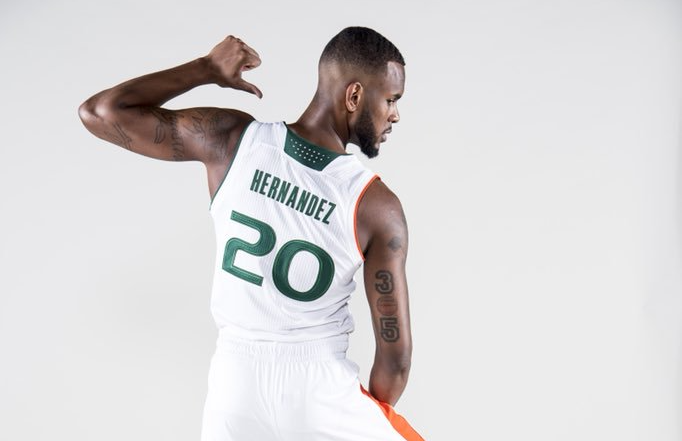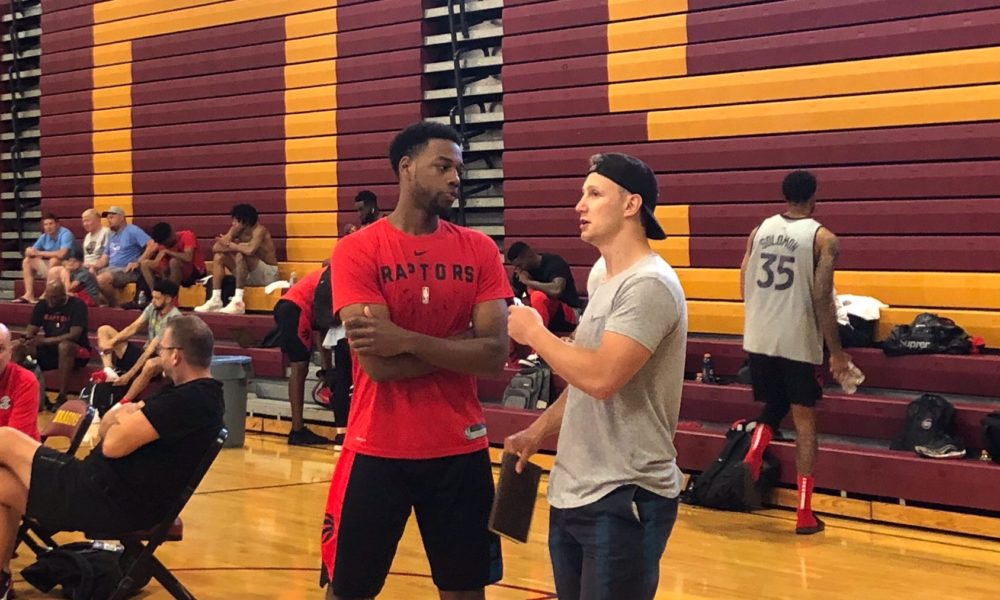Jordan Loyd knew that he had missed the moment the ball left his hands. After clawing the Raptors back from a 28 point deficit with a foray of tough buckets, Loyd darted open for a corner three to tie the game. The ball took a funky trajectory as it made its way to the hoop, clanking off of the back iron in synchrony with the final buzzer as Toronto suffered yet another Summer League loss. When asked how he felt lining up for the game-tying shot, Loyd’s frustration was clear to see.
“Rushed,” he said.
An underwhelming team performance and a miss in that manner would frustrate most young players. It may even trigger them to force the issue moving forward. But Loyd adapted. The very next night, playing against R.J. Barrett and the New York Knicks, he looked anything but rushed, shifting from his role as a bucket-getter into a floor general. Loyd dissected New York with knifing passes to finally get his teammates wide-open looks during an emphatic victory.
Bouncing between point guard duties and a score-first mentality is a difficult balance, but it is one that Loyd has been navigating for years. Loyd was predominantly a shooting guard throughout his collegiate career but began to develop his playmaking skills during his lone year at the Fort Wayne Mad Ants in the G League and then the following season in Israel at Hapoel Eilat, bumping his assist average to four per game.
Once Loyd signed a two-way deal with the Toronto Raptors after last year’s Summer League, that positional limbo continued. In the days that Loyd was assigned to the full team he was situated off-ball. However, the majority of Loyd’s All-NBA G League campaign for the Raptors 905 placed him back into the lead ball-handler position. Even when playing for the 905, Loyd’s flexibility was tested when the team brought in Kay Felder and then Wade Baldwin IV, two ball-dominant guards that chewed up a large amount of possessions.
“Whatever they want to see, I try to do,” Loyd told Raptors Republic. “In the G League season last year I played a lot of 1, so hopefully I was able to showcase some of my play-making. But I want to be able to do both: playmake when I’m out there, shoot the ball when I’m out there, score, and make good decisions. So whatever they are looking for I try to adapt for myself and my game to better myself and give me a better chance.”
Versatility can be a gift and a curse. On one hand, the ability lends itself to modern day positionless basketball. On the other, it can indicate that a player doesn’t have the requisite skillset to excel in a specific role. Loyd’s scoring ability as a combo guard was never in question, but he did need to sharpen his point guard skills in order to truly claim that versatility as a two position player.
“I wasn’t that comfortable bringing it up versus pressure and making reads,” said Loyd. “I think that was my biggest growth last year was just being able to get others involved and not just myself.”
Once Loyd’s comfort at the point grew, he began to assert himself on the G League. In the final month of the regular season, Loyd averaged 7.2 assists per game and an equally impressive 2.95 assist-to-turnover ratio. Now, Loyd’s playmaking progression is on full display at Summer League, a tournament that has a dearth of selfless guard play. Don’t be distracted by his poor shooting numbers; Loyd may have only shot 31 per cent from the field but he has proven himself a quality scorer over a large enough sample size to quell concerns. What should really catch the eye is how Loyd eviscerated defences in the pick-and-roll, accurately engaging the secondary defender before slipping passes to his rolling big.
The second clip above is especially impressive. Both Knicks defenders assume that Loyd will follow Boucher’s screen towards his left hand and shift to cut off the driving lane inside. With one hard crossover dribble back to his right Loyd preemptively creates an open channel on the outside to deliver a beautiful bounce pass to his rolling big man. It is this deception in the subtle game of cat-and-mouse that separates good from great point guards.
“You know, reading the second and third defender. It’s not just the person that’s guarding you,” Loyd said of the biggest learning curve when playing point guard at a higher level.
Although Loyd’s dominance in the two-man game during the first half was impressive, even more pleasing was his recognition of this fact and the subsequent adjustments he made in the second half to beat the third defender. Loyd understood the gravity that he and his big had generated in the pick-and-roll as help defenders began to make half-steps in his direction. As such, he began to zip the ball to outside shooters that were being offered a few more feet of space.
Loyd caused three defenders to be sucked in on nearly every pick-and-roll action. Three quarters of beating your defender off of the dribble and skewering defensive traps with precise passes will do that. The third defender in both clips is either preoccupied by Loyd or the big rolling towards the paint. The net result? Wide open threes, of course.

On other occasions, Loyd simply exposed off-ball defenders who fell a step behind their man. The wizardry on this lefty dish below drew audible oohh’s and aahh’s from the Vegas crowd.
“You’re reading what five guys on the floor are doing and how it relates to your five guys and you in particular. That decision-making process is one that develops over time, it doesn’t just magically show up,” Raptors Summer League head coach John Goodwillie said of Loyd’s maturation at point guard. “He made good decisions off of the first action. Once he got off the pick-and-roll, once he came off of the DHO, he made good decisions and was able to find the pocket pass a couple of times.”
It hasn’t always been this easy for Loyd to direct a team offence.
“I had to work on my ball handling a little bit more,” he recalled. “I was kind of forced into that role [point guard]. Everyday when you have to be able to play day in, day out at that position you’re gonna start doing things that you never even thought of. It really was getting game reps, in-game experience at that position.”
Loyd’s improvement as a ballhandler and understanding reads has created a calmness in his point guard play, especially in being able to control the offensive tempo. In his limited NBA time last season, Loyd showed flashes of pushing the ball ahead off of misses to initiate early offence and easy looks. He diced G League opposition in these scenarios as well without falling into the chaotic frenzy that those games often become. Loyd decides when the game speeds up rather than reacting to it.
“If you see guys in front of you, I always try to get the ball ahead and get them involved. I think the pitch ahead is a great option for any offence in transition. You just gotta gauge it, you know, how the game is going and how the game is flowing. If you’re on a run, keep pushing it, but if you’ve had a couple of bad possessions, try to slow it down,” said Loyd.
The effect that Loyd’s mentality had on the rest of the team was clear to see. Malcolm Miller, who had been in a noticeable funk in the opening two games, was offered a bounty of wide-open shots courtesy of Loyd’s vision to break out of his slump.
“He knew where my spots were,” Miller said of Loyd. “If we get stops we can get out in transition and that’s when everybody eats.”
Loyd’s versatility as a combo guard is now real. He is a legitimate playmaker for others as well as a natural scorer. Loyd sees multi-positional utility as one of his biggest selling points.
“I don’t really have a preference. At the NBA level you gotta be able to play both,” said Loyd.
And Loyd is good enough to play at the NBA level. If he were able to increase his 36.3 per cent shooting from three by just a hair, that claim would be undeniable. As it stands, earning those minutes in Toronto remains a difficult proposition. Alas, being a part of a championship team with great depth has its drawbacks.
Loyd simply hasn’t gotten the opportunity to shine and this season figures to be equally as tough to crack the rotation. Kyle Lowry and Fred VanVleet remain as the two most prominent on-ball presences, while there are whispers that Patrick McCaw may shift towards more of a point guard role.
The Raptors also possess great leverage by having Loyd on a two-way deal, a contract that doesn’t affect their cap number and means that he is limited to only 45 days of service with their full team. Loyd’s value far exceeds a two-way contract, making it such a great deal for Toronto that they wouldn’t be incentivized to convert it to a full contract which would cut into their roster flexibility. But if Loyd continues to progress at the rate he has, it will become incredibly difficult to deny him NBA opportunity that he deserves.



